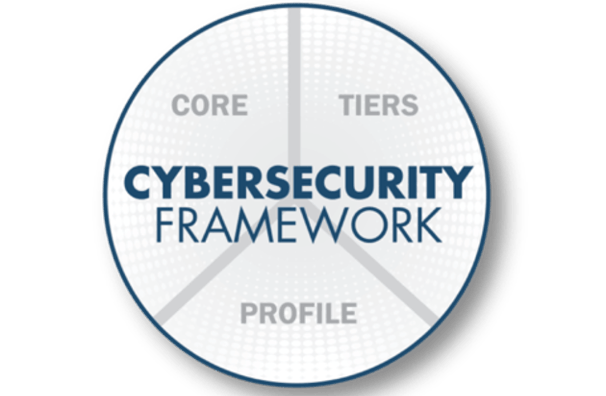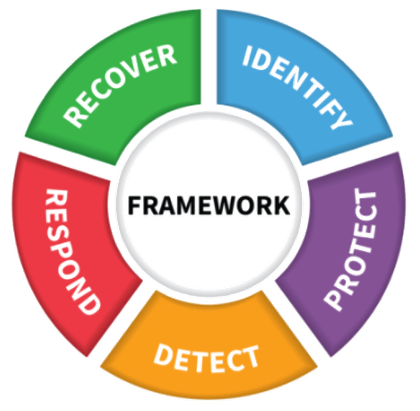NIST CSF
SecureKnots provides NIST (National Institute of Standards and Technology) Cybersecurity Framework consulting and compliance services
Components of the Framework
The Cybersecurity Framework consists of three main components - the Core, Implementation Tiers, and Profiles.


Three Primary Components
Core
Desired cybersecurity outcomes organized in a hierarchy and aligned to more detailed guidance and controls
Profiles
Alignment of an organization’s requirements and objectives, risk appetite and resources using the desired outcomes of the Framework Core
Implementation Tiers
A qualitative measure of organizational cybersecurity risk management practices


Key Framework Attributes
Principles of the Framework CORE
•Common and accessible language
•Adaptable to many technologies, lifecycle phases, sectors and uses
•Risk-based
•Based on international standards
•Living document
•Guided by many perspectives – private sector, academia, public sector
Key Benefits of NIST CSF Certification
SecureKnots offers comprehensive NIST CSF certification services tailored to help organizations implement the framework effectively. Our certified professionals conduct thorough assessments, provide expert guidance on implementing necessary security controls, and assist in remediation efforts to achieve and maintain certification.
Regulatory Alignment: Alignment with NIST CSF framework helps organizations meet regulatory requirements and industry standards for cybersecurity, ensuring compliance with relevant regulations and guidelines.
Continuous Improvement: NIST CSF provides a framework for continuous improvement in cybersecurity practices, enabling organizations to adapt to evolving cyber threats and challenges.
Competitive Advantage: Achieving NIST CSF certification can give your organization a competitive edge, demonstrating your commitment to cybersecurity excellence to clients, partners, and stakeholders.


Why Choose SecureKnots for NIST Cybersecurity Framework Consulting?
We specialize in providing top-tier consulting services to align your organization with the National Institute of Standards and Technology (NIST) Cybersecurity Framework. Our approach is crafted to fortify your cybersecurity posture, ensuring resilience and compliance with industry-leading standards.
Deep Understanding of NIST Framework
SecureKnots brings a profound understanding of the NIST Cybersecurity Framework, ensuring a tailored approach to meet the specific needs and challenges of your organization.
Comprehensive Framework Assessments
Our expert consultants conduct thorough assessments, providing a detailed view of your current cybersecurity posture in relation to the NIST Framework and offering actionable insights for improvement.
Collaborative Partnership
Beyond delivering reports, our consulting services foster a collaborative partnership. We engage with your team, ensuring a deep understanding of your cybersecurity processes and fostering a relationship that strengthens your overall security posture.






Your Questions, Our Expertise
Who should use the Framework?
The Cybersecurity Framework is for organizations of all sizes, sectors, and maturities.
While the Framework was designed with Critical Infrastructure (CI) in mind, it is extremely versatile.
The Framework is outcome driven and does not mandate how an organization must achieve those outcomes, it enables scalability. A small organization with a low cybersecurity budget, or a large corporation with a big budget, are each able to approach the outcome in a way that is feasible for them. It is this flexibility that allows the Framework to be used by organizations which are just getting started in establishing a cybersecurity program, while also providing value to organizations with mature programs.
What are NIST Control Families?
The NIST Cybersecurity Framework has 20 distinct control families, outlined in NIST SP 800-53, which consist of base controls and control enhancements.
Base controls are the fundamental controls that need to be implemented to meet that particular objective or address a certain risk. Control enhancements are applied to base controls to augment them and offer additional security for especially sensitive data or systems. NIST also emphasizes the importance of policies and procedures that document an organization’s approach to managing cybersecurity risk and addressing each area of the NIST control families in some capacity.
How often should my organization undergo NIST CSF certification assessments to maintain certification?
The frequency of NIST CSF certification assessments depends on factors such as changes to your organization’s risk profile, updates to the framework, and industry regulations. SecureKnots can provide guidance on the appropriate timing and frequency of assessments to ensure ongoing certification.
Functions of the NIST Framework
The NIST CSF defines five core functions that together address cybersecurity risks. The five functions of the NIST CSF are: Identify, Protect, Detect, Respond, and Recover. These functions are further broken down into 23 Categories. NIST emphasizes that these functions must work in tandem and continuously to achieve optimal results and combat the dynamic threat landscape.
NIST also asks companies to consider their target tier of implementation or maturity. As part of that assessment, the business should consider their overall “profile,” or the unique combination of business objectives, threats, and regulatory and compliance requirements and controls that make up the company.
WITH OUR SHORT BLOGS
STAY UP TO DATE
Copy Rights @ 2023 SecureKnots. All Rights Reserved.
CONTACT US
Contact@Secureknots.com
USA
+1-302-601-2346
+1-302-608-6708
INDIA
080-31658865
GET IN TOUCH
